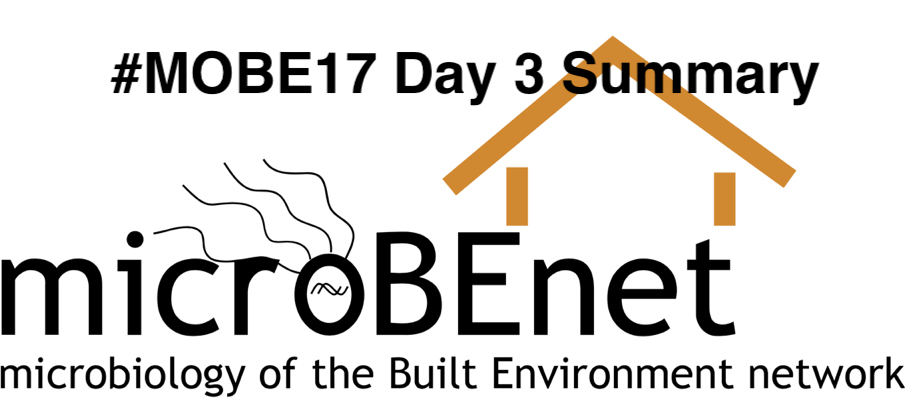The third and final day started with a Keynote talk by Marc Edwards about “MoBE, Public Health and the Flint Water Crisis”. It’s really hard to sum up this talk, I would recommend watching the video if interested. Marc talked about the Flint crisis from their perspective, starting with their pre-existing work on corrosion and Legionella. He wandered around the intersection between scientists, engineers, politics, and the public. He told some chilling stories about the dangers of misinformation by scientists.
The first session of the day was chaired by Scott Kelley and titled “From MoBE Research of MoBE Applications”. The talks were by Jack Gilbert, Richard Shaughnessy, and Anders Nygaard.
- Jack Gilbert emphasized that everyone has a unique microbiome and that this has implications for precision medicine, forensics, and beyond. He talked about work in homes with pets and microbial transfer between people, microbial forensics, antibiotic resistance, hospitals, and more.
- Richard Shaughnessy talked about buildings science and microbiome work on various Native American schools… a population susceptible to asthma and historically underserved and underfunded.
- Anders talked about his work on Norwegian kindergartens. He described a longitudinal study in a few different kindergartens, and that the exhaust air looked similar across schools even though the intake air differed significantly.
The next session was titled “The Building Science – MoBE nexus (Part 1)” and chaired by Rich Corsi. The two talks here were by Rich Corsi and Amy Pruden.
- Rich Corsi described a lot of hidden spaces in building and how prone buildings are to mistakes that have potential human health consequences. He used the phrase “building chemotherapy” to describe our treatment of buildings which I thought was an interesting analogy. He emphasized that there’s a lot of chemistry going on on surfaces, particles (including microbes) are doing stuff with that chemistry.
- Amy talked about some of their work on premise plumbing, specifically in the context of prebiotic and probiotic approaches to microbial control. She made the point that we are already doing prebiotic control (e.g. chlorine, pipe materials, pH, etc) so it might as well be informed. She thinks it’s early yet for probiotic approaches in water but that the day may not be too far off.
After lunch we got rolling again with “The Building Science – MoBE nexus (Part 2)” with talks by Betsy Pugel, Kent Duffy, and Wendy Goodson.
- Betsy Pugel works in Planetary Protection for NASA and gave a good introduction to their mission and goals. In particular she presented some interesting work about material surfaces and how the type and smoothness of those materials influences bacterial adhesion and growth (the shape of the bacteria matters as well).
- Duffy gave a talk from his perspective as an architect, coming only recently into the microbial field. He showed designs and pictures from a number of passive buildings that his firm has designed. They had partnered with the BioBE Center so some of their buildings were used in the early MoBE studies.
- Wendy Goodson works for the Air Force and gave her talk on the microbiomes of military aircraft and their potential effect on corrosion. She placed a strong emphasis on culturing (allowing them to do corrosion experiments and get genomes) and on quantitative measures of biocontamination.
We then moved on to discussing the “NAS Microbiomes of the Built Environment Consensus Study”, chaired by Katherine Bowman with a study overview talk by Joan Bennett.
Joan gave a summary of the 300 page report which can be found here.
The day and the meeting were wrapped up with a panel discussion led by Jonathan Eisen “Charting MoBE Research Priorities” and the panel consisted of Jordan Peccia, Amy Pruden, and Rachel Adams.
It’s hard to summarize a free-ranging panel discussion with significant audience input. The theme was about where to go next and the consensus seemed to be that focusing on specific applications and on health impacts would be the way to go. There were also calls for technological improvements that would move the field forward.
A great meeting and many thanks to the National Academy of Sciences for hosting, for Paula and the Sloan Foundation for driving it all, to all the sponsors, and to Lynn Schriml who did a fabulous job organizing the whole thing.
